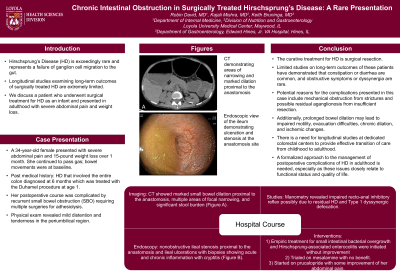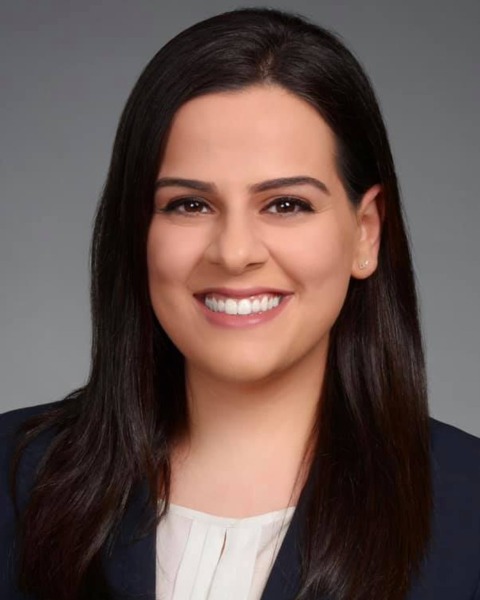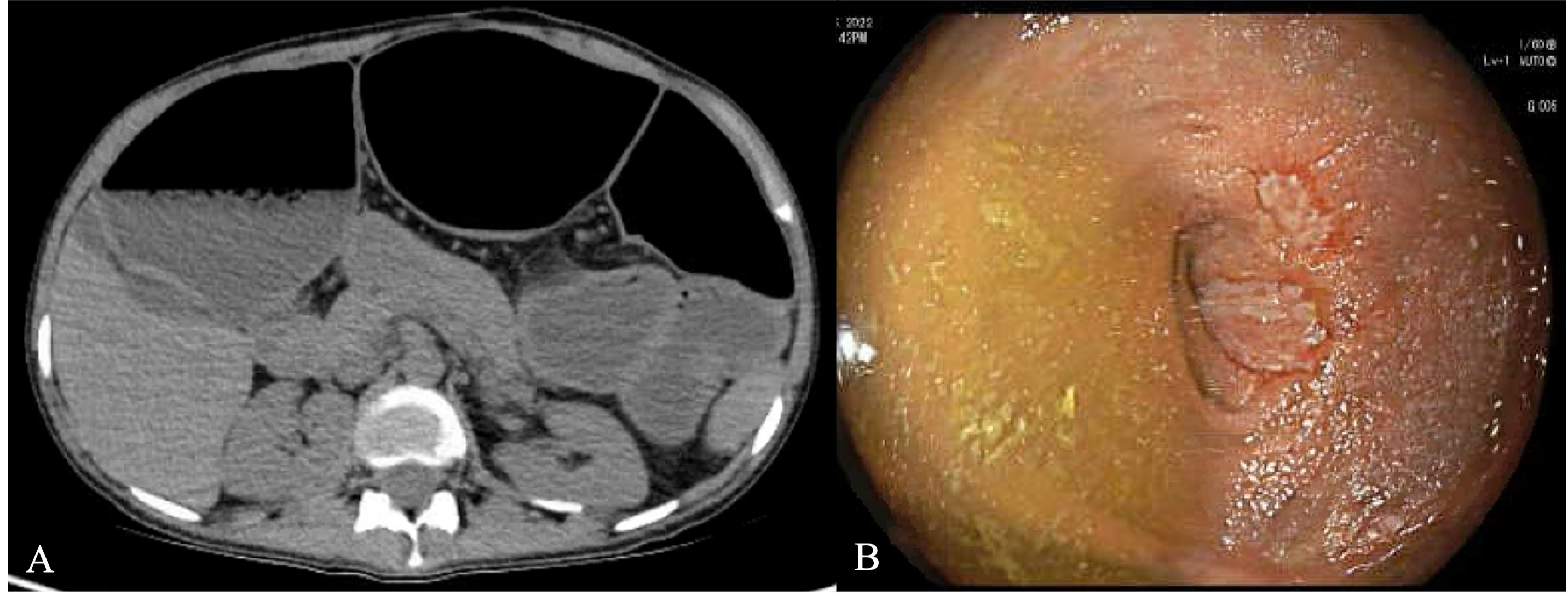Back


Poster Session C - Monday Afternoon
Category: Small Intestine
C0669 - Chronic Intestinal Obstruction in Surgically Treated Hirschsprung’s Disease: A Rare Presentation
Monday, October 24, 2022
3:00 PM – 5:00 PM ET
Location: Crown Ballroom

Has Audio

Robin David, MD
Loyola University Medical Center
Maywood, IL
Presenting Author(s)
Robin David, MD1, Kajali Mishra, MD1, Keith Bruninga, MD2
1Loyola University Medical Center, Maywood, IL; 2Edward Hines, Jr. VA Hospital, Maywood, IL
Introduction: Hirschsprung’s Disease (HD) is exceedingly rare and represents a failure of ganglion cell migration to the gut. Longitudinal studies examining long-term outcomes of surgically treated HD are extremely limited. We discuss a patient who underwent surgical treatment for HD as an infant and presented in adulthood with severe abdominal pain and weight loss.
Case Description/Methods: A 34-year-old female presented with severe abdominal pain and 15-pound weight loss over 1 month. She had a history of HD that involved the entire colon diagnosed at 6 months which was treated with the Duhamel procedure at age 1. Her postoperative course was complicated by recurrent small bowel obstruction (SBO) requiring multiple surgeries for adhesiolysis. She continued to pass gas; bowel movements were at baseline. Physical exam revealed mild distention and tenderness in the periumbilical region. CT showed marked small bowel dilation proximal to the anastomosis, multiple areas of focal narrowing, and significant stool burden (Figure 1A). Endoscopy revealed nonobstructive ileal stenosis proximal to the anastomosis and ileal ulcerations with biopsies showing acute and chronic inflammation with cryptitis (Figure 1B). Empiric treatment for small intestinal bacterial overgrowth and Hirschsprung-associated enterocolitis were initiated without improvement. She was also trialed on mesalamine with no benefit. Manometry revealed impaired recto-anal inhibitory reflex possibly due to residual HD and Type 1 dyssynergic defecation. She was started on prucalopride with some improvement of her abdominal pain. Providing non-invasive venting options remains an ongoing challenge.
Discussion: The curative treatment for HD is surgical resection and the limited studies on long-term outcomes of these patients have demonstrated that constipation or diarrhea are common, and obstructive symptoms or dyssynergia are rare. Potential reasons for the complications presented in this case include mechanical obstruction from strictures and possible residual aganglionosis from insufficient resection. Additionally, prolonged bowel dilation may lead to impaired motility, evacuation difficulties, chronic dilation, and ischemic changes. There is a need for longitudinal studies at dedicated colorectal centers to provide effective transition of care from childhood to adulthood as well as a formalized approach to the management of postoperative complications of HD in adulthood, especially as these issues closely relate to functional status and quality of life.

Disclosures:
Robin David, MD1, Kajali Mishra, MD1, Keith Bruninga, MD2. C0669 - Chronic Intestinal Obstruction in Surgically Treated Hirschsprung’s Disease: A Rare Presentation, ACG 2022 Annual Scientific Meeting Abstracts. Charlotte, NC: American College of Gastroenterology.
1Loyola University Medical Center, Maywood, IL; 2Edward Hines, Jr. VA Hospital, Maywood, IL
Introduction: Hirschsprung’s Disease (HD) is exceedingly rare and represents a failure of ganglion cell migration to the gut. Longitudinal studies examining long-term outcomes of surgically treated HD are extremely limited. We discuss a patient who underwent surgical treatment for HD as an infant and presented in adulthood with severe abdominal pain and weight loss.
Case Description/Methods: A 34-year-old female presented with severe abdominal pain and 15-pound weight loss over 1 month. She had a history of HD that involved the entire colon diagnosed at 6 months which was treated with the Duhamel procedure at age 1. Her postoperative course was complicated by recurrent small bowel obstruction (SBO) requiring multiple surgeries for adhesiolysis. She continued to pass gas; bowel movements were at baseline. Physical exam revealed mild distention and tenderness in the periumbilical region. CT showed marked small bowel dilation proximal to the anastomosis, multiple areas of focal narrowing, and significant stool burden (Figure 1A). Endoscopy revealed nonobstructive ileal stenosis proximal to the anastomosis and ileal ulcerations with biopsies showing acute and chronic inflammation with cryptitis (Figure 1B). Empiric treatment for small intestinal bacterial overgrowth and Hirschsprung-associated enterocolitis were initiated without improvement. She was also trialed on mesalamine with no benefit. Manometry revealed impaired recto-anal inhibitory reflex possibly due to residual HD and Type 1 dyssynergic defecation. She was started on prucalopride with some improvement of her abdominal pain. Providing non-invasive venting options remains an ongoing challenge.
Discussion: The curative treatment for HD is surgical resection and the limited studies on long-term outcomes of these patients have demonstrated that constipation or diarrhea are common, and obstructive symptoms or dyssynergia are rare. Potential reasons for the complications presented in this case include mechanical obstruction from strictures and possible residual aganglionosis from insufficient resection. Additionally, prolonged bowel dilation may lead to impaired motility, evacuation difficulties, chronic dilation, and ischemic changes. There is a need for longitudinal studies at dedicated colorectal centers to provide effective transition of care from childhood to adulthood as well as a formalized approach to the management of postoperative complications of HD in adulthood, especially as these issues closely relate to functional status and quality of life.

Figure: A: CT demonstrating areas of narrowing and marked dilation proximal to the anastomosis
B: Endoscopic view of the ileum demonstrating ulceration and stenosis at the anastomosis site
B: Endoscopic view of the ileum demonstrating ulceration and stenosis at the anastomosis site
Disclosures:
Robin David indicated no relevant financial relationships.
Kajali Mishra indicated no relevant financial relationships.
Keith Bruninga indicated no relevant financial relationships.
Robin David, MD1, Kajali Mishra, MD1, Keith Bruninga, MD2. C0669 - Chronic Intestinal Obstruction in Surgically Treated Hirschsprung’s Disease: A Rare Presentation, ACG 2022 Annual Scientific Meeting Abstracts. Charlotte, NC: American College of Gastroenterology.
